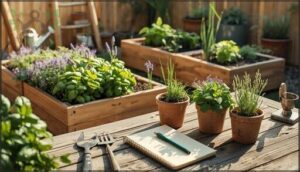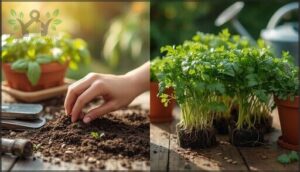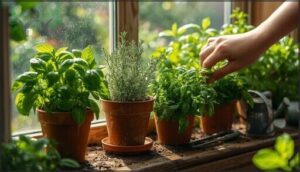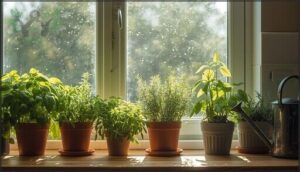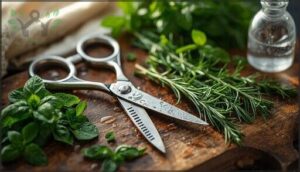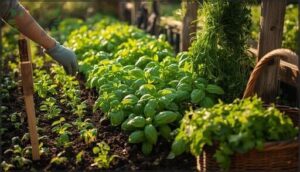This site is supported by our readers. We may earn a commission, at no cost to you, if you purchase through links.
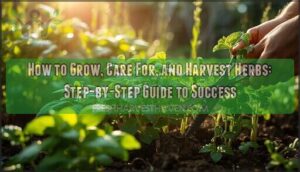
Every garden begins as a handful of hope and a pinch of curiosity, but few journeys feel as rewarding as planting and harvesting your own herbs. Bright basil leaves sparked with summer’s warmth, mint running wild and fragrant after a rain, oregano trailing low along a sunlit path—herb gardening pulls you into nature’s rhythm, teaching patience and generosity.
Anyone who’s snipped parsley for supper knows that flavor doesn’t travel far from the garden bed. With a few thoughtful choices and a bit of careful tending, you’ll find yourself with a bounty of fresh herbs, ready to transform every meal and moment.
Table Of Contents
- Key Takeaways
- Choosing The Best Herbs to Grow
- Planning and Designing Your Herb Garden
- Starting Herbs From Seeds or Transplants
- Essential Care for Healthy Herb Plants
- Growing Herbs Indoors Year-Round
- Harvesting Herbs for Maximum Flavor
- Preserving and Storing Your Herb Harvest
- Frequently Asked Questions (FAQs)
- Can herbs cross-pollinate and affect flavor quality?
- What companion plants work best with herbs?
- How do weather changes impact herb growth?
- Which herbs attract beneficial insects to gardens?
- Do herbs need winter protection in cold climates?
- How do you overwinter perennial herbs outdoors?
- Can herbs regrow after heavy harvesting?
- What herbs repel common garden pests naturally?
- How can I propagate herbs from cuttings?
- Are there signs of overwatering herbs to watch for?
- Conclusion
Key Takeaways
- Choose herbs that match your cooking style, available sunlight, and indoor or outdoor space for the healthiest garden.
- Mixing compatible herbs in containers or garden beds boosts flavor, yield, and natural pest control while saving space.
- Starting from seed or transplant, focus on good soil, proper watering, and organic feeding, then prune regularly for strong growth and higher harvests.
- Dry, freeze, or store your herbs in airtight containers away from heat and light to make flavors last long after the season ends.
Choosing The Best Herbs to Grow
Choosing the right herbs for your space is the first step to a thriving garden. Consider your favorite flavors, how much sunlight you have, and where you’d like your plants to grow.
Let’s look at some of the best options to get you started.
Popular Annual and Perennial Herbs
Think of your herb choices as a tailor-made kitchen bouquet. Annual herbs like basil varieties burst with flavor in a single season, while perennial herbs such as rosemary thrive for years. Many gardeners appreciate the low maintenance nature of perennials.
Here are five pantry staples to think about:
- Basil (Annual)
- Mint (Perennial)
- Oregano types (Perennial)
- Parsley (Biennial, often grown as Annual)
- Chive propagation (Perennial)
Culinary and Medicinal Herb Varieties
Once you’ve chosen your annual and perennial staples, widen your palette with culinary herbs like basil varieties, classic mint types, or hearty thyme. For wellness, ginseng cultivation and echinacea benefits stand tall in herbal medicine. Growing these herbs at home can help conserve populations of native plants.
The herb trade weaves together food and health, reminding us your homegrown basil or mint connects to kitchen and apothecary worldwide.
Homegrown basil or mint bridges food and wellness, linking your kitchen to herbal traditions found in apothecaries worldwide
| Culinary Herbs | Medicinal Herbs |
|---|---|
| Basil, Thyme, Mint | Echinacea, Ginseng |
| Oregano | Black Cohosh |
Selecting Herbs for Indoor or Outdoor Gardens
Balancing Light Requirements and Space Considerations unlocks your herb garden’s true potential. Indoor herb gardens shine with compact, shade-tolerant picks like chives and parsley—especially when outdoor space is tight.
Outdoor gardening suits sun seekers like rosemary and basil, thriving when you match soil pH, watering needs, and local climate zones. Let your growing herbs reflect your space and seasonal rhythms.
Planning and Designing Your Herb Garden
Designing your herb garden starts with a bit of planning, no matter how much space you have. You’ll want to think about how different herbs can grow together and what works best for your lifestyle.
Let’s look at some simple ways to arrange your herbs to fit your needs.
Which Herbs Can Be Planted Together
Did you know mixing the right herbs can improve both yield and pest deterrence in your herb garden? Companion planting—with Mediterranean herb guilds like rosemary, thyme, oregano, and sage—brings natural harmony, while knowing which herbs, like mint or basil, prefer distance prevents allelopathic effects.
Smart pairings make growing herbs easier, leading to happier harvests and thriving plants.
Small Space and Container Gardening Solutions
With herb gardening, space optimization is your best friend—vertical gardening lets balcony herbs reach new heights, while smart container selection means even window boxes and railing planters pack a punch.
Dwarf varieties thrive in small space gardening, making container gardening an easy entryway to growing herbs.
These herb gardening tips guarantee flavor and fragrance, no matter your home’s footprint.
Herb Garden Layout Ideas for Beginners
Visual harmony creates more than beauty—it boosts your yield and joy. Starting an Herb Garden? Symmetry benefits growth and streamlines care, while space optimization lets every inch thrive. Try these beginner-friendly designs:
- Quadrant beds for organized Herb Garden Design
- Herb spirals—perfect for Small Space Gardening
- Companion planting rows for easy harvest
- Wheel layouts for stunning Layout variety
Starting Herbs From Seeds or Transplants
Getting herbs started is easier than you might think, and you have a few good options for how to begin. Some folks plant seeds, while others prefer ready-to-go transplants.
Let’s look at what you need to know about both approaches.
Seed Starting and Transplanting Tips
Ever wonder why some seedlings leap ahead while others stall? For a strong start in herb gardening, sow seeds at their best depth and consider using seedling heat mats to boost germination.
Track your planting dates—accurate schedules lead to better results. Watch soil salinity, since high levels can dampen growth, and reduce transplant shock with gentle handling and prompt planting.
Recommended Potting Mixes and Soil Amendments
When planning your herb garden, getting the soil right sets the stage for success. Peat moss alternatives like coconut coir, blended with compost, deliver moisture and nutrients for growing herbs.
Don’t forget soil pH testing—most herbs thrive near neutral. Refresh container soil yearly, and consider compost tea benefits or diverse organic fertilizer types for ongoing herb care and planting strength.
When and How to Fertilize Herbs
Getting fertilizer timing right can feel like threading a needle—too much or too little makes all the difference in Herb Garden maintenance. Start feeding early in spring with balanced NPK ratios, and use gentle application methods, especially when growing herbs in containers.
Keep a watchful eye: plant monitoring prevents over-fertilization risks, preserving the flavor and health of your favorite herbs.
Essential Care for Healthy Herb Plants
Caring for herbs is mostly about paying attention to their basic needs and making small adjustments as they grow. A few simple habits can make the difference between plants that limp along and ones that really thrive.
Here’s what to keep in mind as you look after your herb garden.
Soil, Light, and Water Requirements
Curious what the secret is to lush herbs? It’s all about tuning in to their needs. Aim for ideal soil pH (6.0–7.0) and boost organic matter content for strong roots. Prioritize at least six hours of full sun for the right light spectrum needs and adopt watering best practices—a steady rhythm bolsters growth and healthy drought stress response.
- Loose, sandy loam encourages root vigor.
- Water at the base to avoid disease, adjusting frequency for each herb.
- Herbs thrive with consistent moisture but despise soggy roots.
- South-facing windows or grow lights benefit indoor growing.
Fertilization and Organic Growing Practices
Let’s talk about nourishing those thriving herbs. Soil health sits at the core, so organic amendments like compost and aged manure are your friends. Blending the right fertilizer types means steady nutrient availability and happier roots.
Sustainable gardening practices—like mulching and rotating your containers—support vigorous growth and flavor. Think of organic gardening as feeding your soil, not just your plants.
Pruning and Pinching for Vigorous Growth
Pruning Techniques and Pinching Benefits go hand-in-hand for vigor maintenance in any herb bed. Taking a little off the top—especially 4 to 6 inches from tender herbs—stimulates rich regrowth and higher yields. Early morning snips encourage branching, improve leaf growth, and keep plants bushy.
Smart Growing Herbs strategies like this make harvesting herbs a joyful, ongoing garden ritual.
Pest and Disease Prevention Methods
Healthy herb growth isn’t just about smart snips. Consistent Plant Care includes watching for Common Herb Problems and choosing prevention first. For example, you’ll boost Garden Maintenance by weaving in Organic pesticides, Companion planting, Soil solarization, and Disease resistance.
Four quick habits:
- Scout often
- Rotate crops
- Use Physical barriers
- Clean debris regularly
Growing Herbs gets simpler this way!
Growing Herbs Indoors Year-Round
Bringing herbs indoors lets you enjoy fresh flavor, even when the weather outside isn’t ideal. With the right setup, you can keep your favorite plants thriving all year long.
Let’s look at some of the best options for growing herbs inside, no matter the season.
Best Herbs for Indoor Gardening
Think of your kitchen windowsill as your indoor oasis, where basil, mint, and chives flourish with just a little care. These beginner herbs are forgiving, thriving in containers of nearly any size.
If you’re drawn to hydroponic herbs, basil is especially high-yield. When growing herbs indoors, watch for common pests and match container size to your plant’s needs.
Light and Temperature Requirements
For your indoor herb garden, balancing ideal lighting and steady temperatures is key to strong, flavorful growth. Herbs crave 12–16 hours of light and steady warmth—think 64–75°F. Indoor control matters, since temperature stress stunts leaves, while poor light leaves basil and chives leggy. Watch for these failure indicators as essential plant care and maintenance.
- Boost with LED grow light
- Maintain steady 64–75°F
- Adjust for seasonal changes
- Watch for wilt or pale leaves
- Adapt watering for lighting shifts
Tips for Using Grow Lights and Windowsills
With your herb planting adventure, a bit of planning boosts results. Set your LED grow light for a 14–16 hour light duration, using full-spectrum bulbs close to your plants for lush, compact growth. South-facing windowsills work well too—just move pots for even exposure. Watering care rises with increased indoor gardening light, so adjust accordingly for strong, thriving herbs.
| Tip | Why It Matters |
|---|---|
| Full-Spectrum LED, 14–16h | Mimics best sunlight |
| 6–12″ Placement Setup | Even growth, less spindly |
| Timers for Automation Consistency | Prevents missed cycles |
Harvesting Herbs for Maximum Flavor
Knowing when and how to harvest your herbs makes all the difference in taste and freshness. With a few easy habits, you can enjoy a steady supply of flavorful leaves all season long.
Here’s what you need to keep in mind.
When and How to Harvest Different Herbs
Did you know the right moment can make or break flavor? For peak taste, time your harvesting techniques to each plant—like cutting basil when it has several leafy sets, using mid-morning for rosemary timing, or picking mint right before flowering.
Following proper mint frequency, oregano techniques, and thyme scheduling ensures your fresh herbs or dried herbs keep their magic for every dish.
Tools and Cutting Methods to Prevent Damage
Ever notice how a bruised herb wilts before your eyes? That’s tool choice at work.
For growing and harvesting herbs, reach for sharp pruners or specialty scissors—clean and sterilized for safety. Cut at a 45-degree angle with ergonomic designs, then maintain blades carefully.
These harvesting techniques reduce damage, extend herb preservation time, and keep flavors vibrant on your plate.
Harvesting Schedules for Continuous Supply
Picture your herbs as a relay team—succession planting keeps the baton moving, ensuring no gaps in flavor. Time your harvests just right, letting each plant regrow before its next trim.
Multiple harvests boost your fresh herbs yield, but don’t rush—balance regrowth rates and watch for environmental impact, so you’re always ready for freezing herbs, drying herbs, or tossing fresh ones straight into supper.
Preserving and Storing Your Herb Harvest
After a good harvest, a little planning goes a long way in keeping those fresh flavors at your fingertips. Preserving herbs is easier than you might think and unlocks plenty of creative uses all year round.
Here are some straightforward ways to save and store your favorite herbs.
Drying, Freezing, and Other Preservation Methods
Looking for ways to keep your harvests flavorful all year? Food Preservation in herb gardening is both science and art. From Drying Herbs for maximum potency, Freezing Herbs to lock in freshness, to creating Oil Preserves or Herb Powders, you’ll savor:
- rich aromas months after harvest,
- bursts of green color,
- and surprisingly, better flavor retention than you’d expect.
Storing Dried and Fresh Herbs for Maximum Flavor
Whether you’re storing fresh or dried herbs, how you handle them shapes every pinch of flavor that winds up in your kitchen. Reach for airtight glass storage containers and tuck them away from heat and sunlight—light and moisture are notorious for shortening herb shelf life. Toss in a food-safe silica pack, and you’ve locked in freshness and vibrant flavor.
Creative Ways to Use and Enjoy Homegrown Herbs
With your fresh or dried herbs stored for peak flavor, the real fun begins—think beyond the spice rack. Brighten dishes with herb oils or vinegars for culinary creations, blend dried mint into tea blends, or craft herbal remedies for wellness.
Infused beverages and simple craft projects, like homemade sachets or bath salts, let your harvest shine in daily rituals.
Frequently Asked Questions (FAQs)
Can herbs cross-pollinate and affect flavor quality?
Cross-pollination in aromatic plants won’t change your herbs’ flavor this season—flavor stability is safe.
Hybridization effects become clear only when you save seeds, grow new plants, and see changes in taste, aroma, or appearance in the following planting.
What companion plants work best with herbs?
Imagine your garden as an orchestra: basil, rosemary, and chives harmonize with tomatoes and beans, naturally boosting yield, deterring pests, and attracting pollinators.
Strategic herb pairings intensify flavor, suppress disease, and offer essential gardening tips.
How do weather changes impact herb growth?
Shifts in temperature, precipitation, solar radiation, and humidity influence everything from immunity and water uptake to flowering and flavor.
Understanding these weather effects shapes your success, making climate viability a cornerstone for growing and caring for herb plants.
Which herbs attract beneficial insects to gardens?
If WiFi signals attracted bees, you’d see dill, fennel, marjoram, mint, lavender, and sage buzzing with activity.
These pollinator-friendly herbs and aromatic plants draw in beneficial insects, supporting pest control and boosting your garden’s ecosystem services naturally.
Do herbs need winter protection in cold climates?
Herbs absolutely need winter protection in cold climates for best survival. Mulching, frost covers, and even indoor herb overwintering are key Herb Gardening and Preservation tips to prevent frost damage and boost cold climate herbs’ survival rates.
How do you overwinter perennial herbs outdoors?
Letting perennial herbs “fend for themselves” through winter would be wicked satire. Without mulch types for root insulation, proper pruning timing, good soil drainage, and the right zone hardiness, you’re gambling with survival. Smart herb gardening prevents regrets.
Can herbs regrow after heavy harvesting?
After heavy harvesting, some herbs—especially perennial types—do regrow, but expect a longer Regrowth Timeline.
Following Best Practices like leaving green growth and spacing out Harvesting Frequency helps maintain your Herb Garden’s vitality and flavor.
What herbs repel common garden pests naturally?
Picture garden pests running for the hills—nature’s little soldiers like basil, catnip, lemongrass, mint, and rosemary patrol your plot.
Use them for essential oil efficacy, natural pest control, and companion planting. Sustainable Gardening is real heroics!
How can I propagate herbs from cuttings?
Choose healthy stems for cutting selection, dip them in rooting hormone, then nestle them into moist rooting mediums.
Monitor humidity control—clear covers or misting help.
With steady warmth and light, roots form in a few weeks—patience pays!
Are there signs of overwatering herbs to watch for?
Yellowing leaves, persistent wilting signs despite moist soil, mushy roots, edema lesions on stems or leaves, and stunted growth are clear warnings.
Keen gardeners know these signals are essential for mastering Herb Gardening for Beginners and plant health.
Conclusion
A garden is a living manuscript, written leaf by leaf—each herb a new line in the ongoing story of your care. Through the rewarding rituals of herb planting and harvesting, you cultivate more than flavors; you nurture patience, coax resilience, and draw daily wonder from the earth itself.
Every clipped stem or gathered sprig carries a memory and a lesson. Let your herbs thrive, and you’ll find your kitchen and spirit enriched, season after season.
- https://www.grandviewresearch.com/industry-analysis/fresh-herbs-market-report
- https://www.mordorintelligence.com/industry-reports/fresh-herbs-market
- https://economictimes.indiatimes.com/news/economy/agriculture/farmers-earning-as-much-as-rs-3-lakh-per-acre-by-cultivating-herbs/articleshow/65802909.cms
- https://pmc.ncbi.nlm.nih.gov/articles/PMC4243263/
- https://finance.yahoo.com/news/fresh-herbs-global-market-analysis-140600154.html

